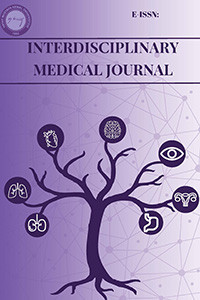Evaluation of the Covid-19 vaccine literacy of the under-vaccinated community in a district in the covid-19 pandemic; example of pursaklar
Evaluation of the Covid-19 vaccine literacy of the under-vaccinated community in a district in the covid-19 pandemic; example of pursaklar
Covid-19, Missing Vaccine, Vaccine Literacy,
___
- Haverkate M, D’Ancona F, Giambi C, Johansen K, Lopalco PL, Cozza V, et al. Mandatory and recommended vaccination in the EU, Iceland and Norway: results of the VENICE 2010 survey on the ways of implementing national vaccination programmes. Eurosurveillance. 2012;17(22):20183. https://doi.org/10.2807/ese.17.22.20183-en
- Fine P, Eames K, Heymann DL. “Herd immunity”: a rough guide. Clinical infectious diseases. 2011;52(7):911-6. https://doi.org/10.1093/cid/cir007
- Biasio LR. Vaccine literacy is undervalued. Human vaccines & immunotherapeutics. 2019;15(11):2552-3. https://doi.org/10.1080/21645515.2019.1609850
- Anand S, Bärnighausen T. Health workers and vaccination coverage in developing countries: an econometric analysis. The Lancet. 2007;369(9569):1277-85. https://doi.org/10.1016/S0140-6736(07)60599-6
- Leask J, Kinnersley P, Jackson C, Cheater F, Bedford H, Rowles G. Communicating with parents about vaccination: a framework for health professionals. BMC pediatrics. 2012;12(1):1-11. https://doi.org/10.1186/1471-2431-12-154
- Wang X, Zhou X, Leesa L, Mantwill S. The effect of vaccine literacy on parental trust and intention to vaccinate after a major vaccine scandal. Journal of health communication. 2018;23(5):413-21. https://doi.org/10.1080/10810730.2018.1455771
- Sørensen K, Van den Broucke S, Fullam J, Doyle G, Pelikan J, Slonska Z, et al. Health literacy and public health: a systematic review and integration of definitions and models. BMC public health. 2012;12(1):1-13. https://doi.org/10.1186/1471-2458-12-80
- Berkman ND, Sheridan SL, Donahue KE, Halpern DJ, Viera A, Crotty K, et al. Health literacy interventions and outcomes: an updated systematic review. Evidence report/technology assessment. 2011(199):1-941. https://doi.org/10.7326/0003-4819-155-2-201107190-00005
- Biasio LR. Vaccine hesitancy and health literacy. Human vaccines & immunotherapeutics. 2017;13(3):701-2. https://doi.org/10.1080/21645515.2016.1243633
- Ratzan SC. Vaccine literacy: a new shot for advancing health. Taylor & Francis; 2011. https://doi.org/10.1080/10810730.2011.561726
- Rowlands G. Health literacy: ways to maximise the impact and effectiveness of vaccination information. Human vaccines & immunotherapeutics. 2014;10(7):2130-5. https://doi.org/10.4161/hv.29603
- Biasio LR, Bonaccorsi G, Lorini C, Pecorelli S. Assessing COVID-19 vaccine literacy: a preliminary online survey. Human vaccines & immunotherapeutics. 2021;17(5):1304-12. https://doi.org/10.1080/21645515.2020.1829315
- TUİK, https://data.tuik.gov.tr/Kategori/GetKategori?p=nufus-ve-demografi-109&dil=1, Erişim Tarihi:22.04.2022.
- Durmuş A, Akbolat M, Amarat M. COVID-19 Aşı Okuryazarlığı Ölçeği’nin Türkçe geçerlilik ve güvenirliliği. Cukurova Medical Journal. 2021;46(2):732-41. https://doi.org/10.17826/cumj.870432
- Nutbeam D. Health literacy as a public health goal: a challenge for contemporary health education and communication strategies into the 21st century. Health promotion international. 2000;15(3):259-67. https://doi.org/10.1093/heapro/15.3.259
- Inoue M, Takahashi M, Kai I. Impact of communicative and critical health literacy on understanding of diabetes care and self-efficacy in diabetes management: a cross-sectional study of primary care in Japan. BMC family practice. 2013;14(1):1-9. https://doi.org/10.1186/1471-2296-14-40
- Ipsos. Aşı Olmayanların Yarısı 18-35 Yaş Grubundan. [Erişim Tarihi: 6 Aralık 2021]. Erişim: https://www.ipsos.com/tr-tr/asi-olmayanlarin-yarisi-18-35-yas-grubundan.
- Uzuner A, Uç D, Dikmen İ, Akman M, Sarısoy M, Güzel S, et al. Altmış beş yaş üstü erişkinlerde aşılanma durumu ve bilgi düzeyleri. The Journal of Turkish Family Physician. 2014;5(3):19-23.
- Arokiaraj MC. Correlation of influenza vaccination and influenza incidence on COVID-19 severity. Available at SSRN 3572814. 2020. http://dx.doi.org/10.2139/ssrn.3572814
- Belongia EA, Osterholm MT. COVID-19 and flu, a perfect storm. American Association for the Advancement of Science; 2020. 10.1126/science.abd2220
- Biasio L, Giambi C, Fadda G, Lorini C, Bonaccorsi G, D’Ancona F. Validation of an Italian tool to assess vaccine literacy in adulthood vaccination: a pilot study. Ann Ig. 2020;32(3):205-22. 10.7416/ai.2020.2344
- Costantini H. COVID-19 Vaccine Literacy of Family Carers for Their Older Parents in Japan. Healthcare (Basel, Switzerland). 2021;9(8). https://doi.org/10.3390/healthcare9081038
- Yayın Aralığı: Yılda 3 Sayı
- Başlangıç: 2023
- Yayıncı: Hatay Mustafa Kemal Üniversitesi Tıp Fakültesi Dekanlığı
Özlem NALBANTOĞLU, Semra GÜRSOY, Tarık KIRKGÖZ, Filiz HAZAN, Behzat ÖZKAN
Breast cancer and the molecular mechanism of estrogen signaling
Yalçın ERZURUMLU, Hatice Kübra DOĞAN
Ömer Faruk TEKİN, Müberra ÇAKICI TOSUN
The role of surgery in perianal disease developing in hematology malignancy patients
Serkan ERKAN, Ramazan GÜNDOĞDU, Murat KUŞ, Hakan YABANOĞLU
Evaluation of serum adipocytokine and interleukin-18 levels in patients with epilepsy
Ahmet DÜNDAR, Derya KILINÇ, Ahmet YILMAZ, Vugar JAFAR, Orhan AYAN, Mehmet Uğur ÇEVİK, Hamza ASLANHAN
Hacer DEMİRKÖSE, Furkan AKYÜZ, Mehmet Enes GÖKLER
The effect of Covid-19 anxiety on prenatal distress and prenatal attachment in pregnant women
Dilay KARADEMİR, Ezgi AĞADAYI, Seher KARAHAN
Monocyte eosinophil ratio and red blood cell distribution width in the diagnosis of asthma
